The Art of Topiary: Classic European Garden Ideas
European gardens have perfected topiary artistry over centuries, creating timeless styles that continue to inspire gardeners worldwide. These classic designs combine precision, symmetry, and artistic vision to create living sculptures that elevate any garden space.
French Formal Garden Topiaries
French formal gardens showcase meticulous geometric precision and perfect symmetry. Create the distinctive French look with cone-shaped boxwoods flanking garden pathways or perfectly trimmed spheres arranged in grid patterns. For a true Versailles-inspired design, incorporate parterre gardens with low boxwood hedges forming intricate patterns viewed from above. French topiaries typically feature yew, boxwood, or privet plants trimmed into tight, controlled forms that emphasize order and human mastery over nature. Position these formal elements along central axes or as sentinels at garden entrances to achieve that quintessential French elegance.
Italian Renaissance Topiary Designs
Italian Renaissance topiary embraces both geometric and whimsical forms, balancing structure with playfulness. Carry out the iconic Italian cypress trees as vertical accents or create multi-tiered topiary with distinct layers reminiscent of the magnificent Villa d’Este gardens. Italian designs often incorporate topiary into broader architectural elements, framing garden rooms or complementing water features. For authentic Italian style, arrange topiaries along terraced levels to create a sense of progression and discovery. Use laurel, boxwood, or myrtle to create these Mediterranean-inspired forms, and position them strategically to frame views of your garden’s focal points or distant landscapes.
10 Stunning Geometric Topiary Shapes for Modern Gardens
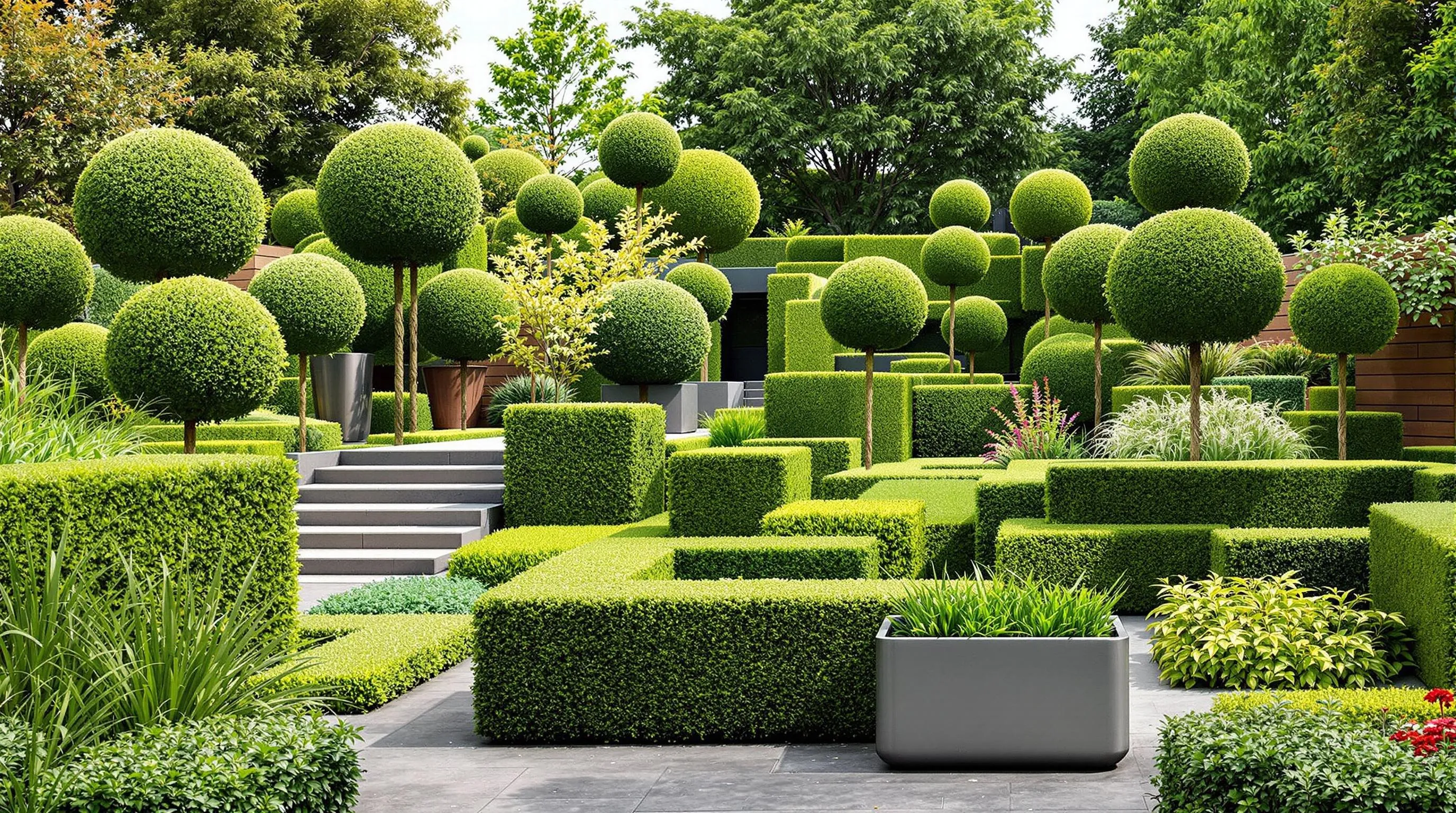
Geometric topiary shapes offer clean lines and architectural precision that perfectly complement modern industry designs. These structured forms create visual interest year-round and serve as striking focal points in contemporary gardens.
Spherical Boxwood Arrangements
Spherical boxwood topiaries bring perfect symmetry and a sense of order to any garden space. These rounded forms can be arranged in varying heights to create rhythm and movement across your industry. Try placing a series of three boxwood spheres in graduated sizes along a pathway or framing an entrance with matching pairs. For added impact, consider installing small industry lighting to illuminate these sculptural elements at night, creating dramatic shadows and highlighting their perfect form. Boxwood (Buxus) varieties like ‘Green Velvet’ and ‘Winter Gem’ maintain their shape exceptionally well with biannual trimming.
Cube and Cone Combinations
Mixing cube and cone shapes creates captivating geometric contrast in modern gardens. Position tall pyramidal cones alongside precise cubes for a ever-changing interplay of forms that draws the eye through your industry. This combination works beautifully in minimalist garden designs where the clean lines of the topiary become the main attraction. For maximum visual impact, plant these shapes in contemporary containers with simple designs, using materials like brushed metal or concrete. Privet (Ligustrum) and yew (Taxus) are excellent choices for these structured forms, offering dense foliage that responds well to precise shaping.
Creating Living Sculptures: Animal-Shaped Topiary Ideas
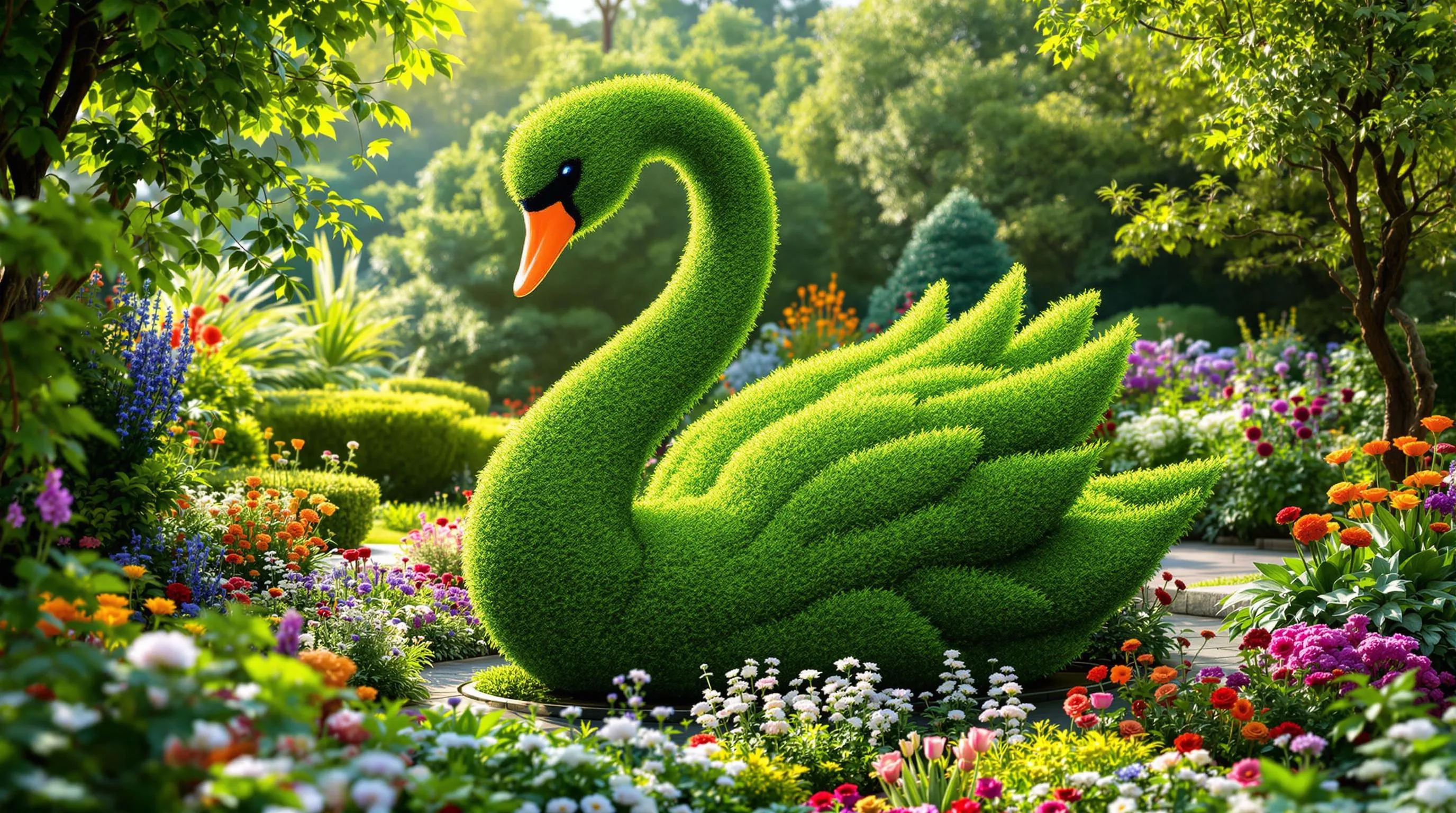
Animal-shaped topiaries transform gardens into enchanting displays that captivate visitors and showcase your creative flair. These living sculptures add personality and whimsy to any outdoor space while serving as impressive focal points.
Whimsical Wildlife Topiaries
Wildlife topiaries bring natural charm to your garden with forms that mimic the beauty of untamed creatures. Create elegant swan topiaries with graceful necks that appear to glide across your lawn, using boxwood or privet for the detailed curves. Deer topiaries work beautifully as garden sentinels, with their slender legs and alert postures crafted from yew or holly. For striking vertical interest, owl topiaries perched on pedestals offer wisdom and character, best shaped from dense evergreens like juniper. Bear topiaries can range from playful cubs to majestic adults, requiring larger shrubs like taxus for proper proportion. For smaller gardens, rabbit topiaries with their distinctive ears and rounded bodies make charming additions without overwhelming the space.
Domesticated Animal Designs
Domesticated animal topiaries create a sense of familiarity and delight in formal and casual gardens alike. Dog topiaries can be customized to resemble your favorite breeds, from terriers to retrievers, using flexible plants like privet or boxwood for detailed features. Cat topiaries with their elegant profiles and arched tails add sophistication to garden corners and entryways. For equestrian enthusiasts, horse topiaries make dramatic statements when positioned as centerpieces, requiring careful planning and regular maintenance to preserve their graceful silhouettes. Peacock topiaries with their spectacular “fanned” tails create stunning visual displays, especially when positioned against walls or at the end of garden paths. For beginners, simple chicken or duck topiaries offer more forgiving shapes that still deliver charm without demanding expert pruning skills.
Small Space Solutions: Container Topiary Gardens
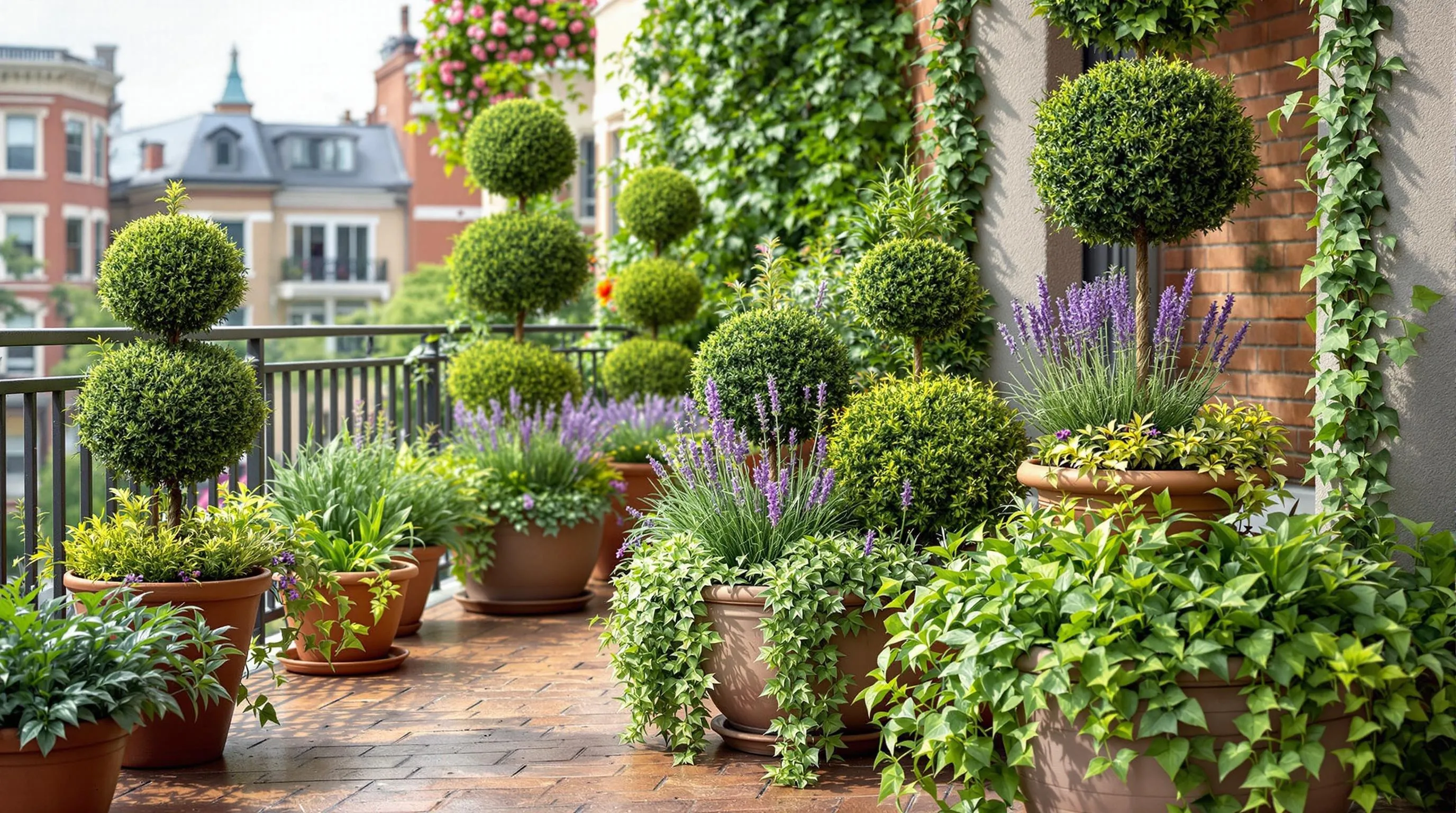
Limited outdoor space doesn’t mean you have to miss out on the beauty of topiary gardens. Container topiaries offer versatile, space-efficient answers that bring sculptural greenery to even the smallest areas.
Portable Potted Topiary Arrangements
Portable potted topiaries transform tiny spaces into verdant retreats with minimal commitment. Choose lightweight fiberglass or plastic containers for easy movement, allowing you to rearrange your display seasonally or for special occasions. Dwarf Alberta spruce and small-leaved boxwood varieties like ‘Green Velvet’ thrive in containers and maintain their shape with minimal pruning. Create instant impact by grouping containers of varying heights, placing taller specimens at the back and shorter ones in front. For maximum flexibility, mount your containers on hidden casters—you’ll have the freedom to reconfigure your garden or protect sensitive plants during harsh weather.
Balcony and Patio Topiary Displays
Maximize vertical space on balconies and patios by incorporating wall-mounted planters or tiered stands for your topiary collection. Rosemary and lavender topiaries offer the dual benefit of sculptural form and aromatic appeal when brushed against. For year-round structure, pair evergreen topiaries with seasonal flowering plants that provide changing color without competing for attention. Use corners with spiral topiaries that draw the eye upward, creating the illusion of greater space. Install railing planters with trailing ivy surrounding central topiary specimens for a lush, layered effect that doesn’t encroach on limited floor space. Remember to consider weight restrictions for balconies—lightweight soil mixes containing perlite or vermiculite provide proper drainage while reducing overall load.
Low-Maintenance Topiary Plants for Beginners
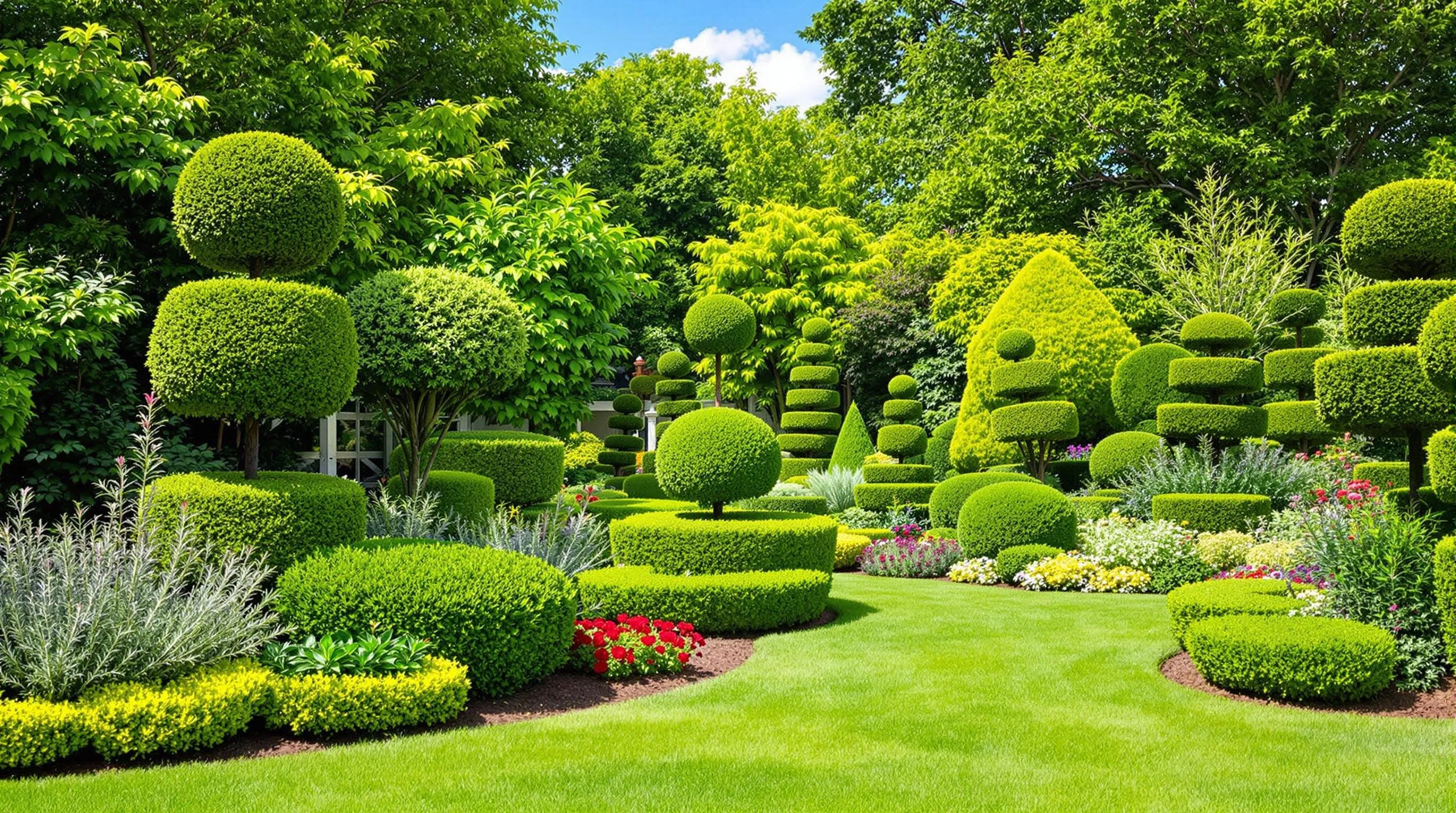
Creating beautiful topiary doesn’t have to be a time-consuming try. For novice gardeners, choosing the right low-maintenance plants can make all the difference in your topiary journey. These varieties forgive occasional neglect while still maintaining their sculptural appeal.
Slow-Growing Evergreen Options
Boxwood (Buxus) varieties top the list for beginner-friendly topiary plants, with dwarf English boxwood (Buxus sempervirens ‘Suffruticosa’) growing just 2-3 inches annually, requiring minimal pruning. Japanese holly (Ilex crenata) offers a boxwood-like appearance but with superior disease resistance and only needs shaping once or twice yearly. Consider Privet (Ligustrum) for its forgiving nature—if you make a pruning mistake, it quickly generates new growth to correct errors. Euonymus japonicus ‘Microphyllus’ presents another excellent option with its tiny leaves that naturally maintain a neat appearance and only require light trimming in spring and summer. These slow-growing options give you ample time to develop your pruning skills without constant maintenance demands.
Drought-Tolerant Topiary Varieties
Rosemary (Rosmarinus officinalis) serves as an ideal drought-resistant topiary choice, doubling as both ornamental and culinary plant while thriving with minimal watering once established. Juniper varieties like Juniperus chinensis ‘Parsoni’ maintain their shape exceptionally well through dry periods and rarely need supplemental water after their first year. Lavender (Lavandula) can be trained into small topiary forms with the bonus of fragrant blooms, requiring only occasional deep watering rather than frequent moisture. For warmer regions, consider Westringia fruticosa (coastal rosemary), an Australian native that withstands extended dry spells while maintaining a dense growth habit perfect for topiary shapes. These drought-tolerant options not only save you time on watering but also reduce overall garden maintenance while still delivering striking sculptural elements.
Seasonal Topiary Garden Transformations
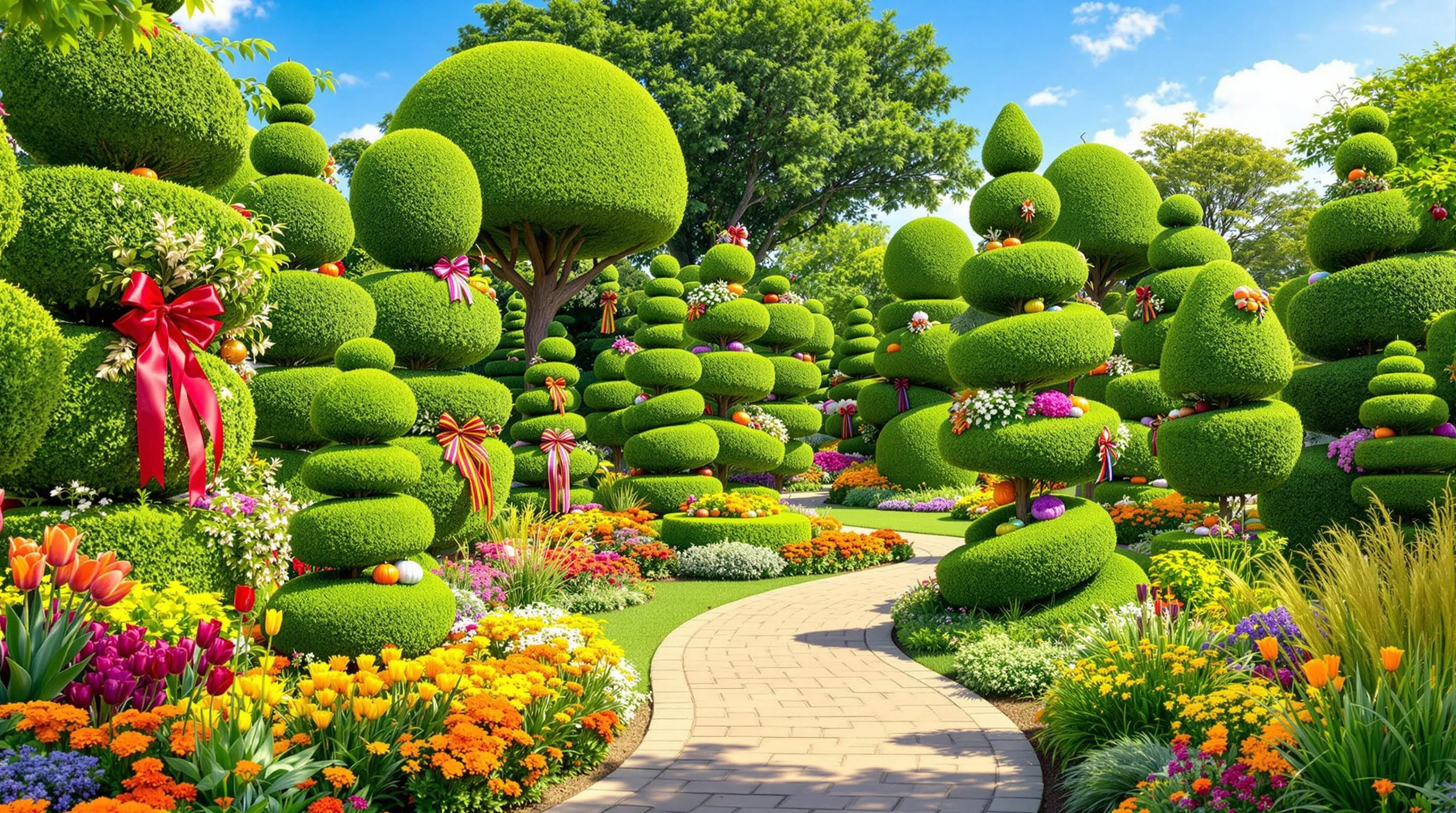
Transform your topiary garden throughout the year with seasonal accents that keep your outdoor space fresh and relevant. With strategic decorations and companion plantings, you can ensure your garden remains vibrant and interesting regardless of the season.
Holiday-Themed Topiary Decorations
Turn your topiaries into festive focal points by incorporating holiday-exact decorations that celebrate each season. For winter holidays, adorn boxwood spirals and cones with twinkling fairy lights, small ornaments, or delicate ribbons that complement your existing garden color scheme. During spring celebrations like Easter, attach small colorful eggs or pastel-colored bows to spherical topiaries. Summer holidays shine when you dress animal-shaped topiaries with patriotic ribbons or tiny banners for Fourth of July displays. In fall, transform your garden by weaving miniature pumpkins, autumn leaves, and rustic burlap accents around the base of your topiaries. These temporary embellishments allow you to maintain the integrity of your carefully shaped plants while adapting them to seasonal celebrations.
Seasonal Color Companion Plantings
Enhance your topiary displays by surrounding them with strategic seasonal companion plantings that provide continuous color and interest. In spring, plant drifts of tulips, daffodils, and hyacinths around the base of formal topiaries to create dramatic color contrasts against the green framework. Summer calls for vibrant annuals like petunias, marigolds, and zinnias to border pathway topiaries, adding movement and texture. Fall transformations come alive with ornamental kale, chrysanthemums, and ornamental grasses that complement the more structured topiary forms. For winter interest, incorporate evergreen ground covers like winter heather, hellebores, and snowdrops that thrive during colder months when other plants go dormant. These thoughtful companion plantings not only highlight your topiary artistry but also ensure your garden maintains visual appeal throughout every season.
Topiary Garden Borders and Hedging Ideas
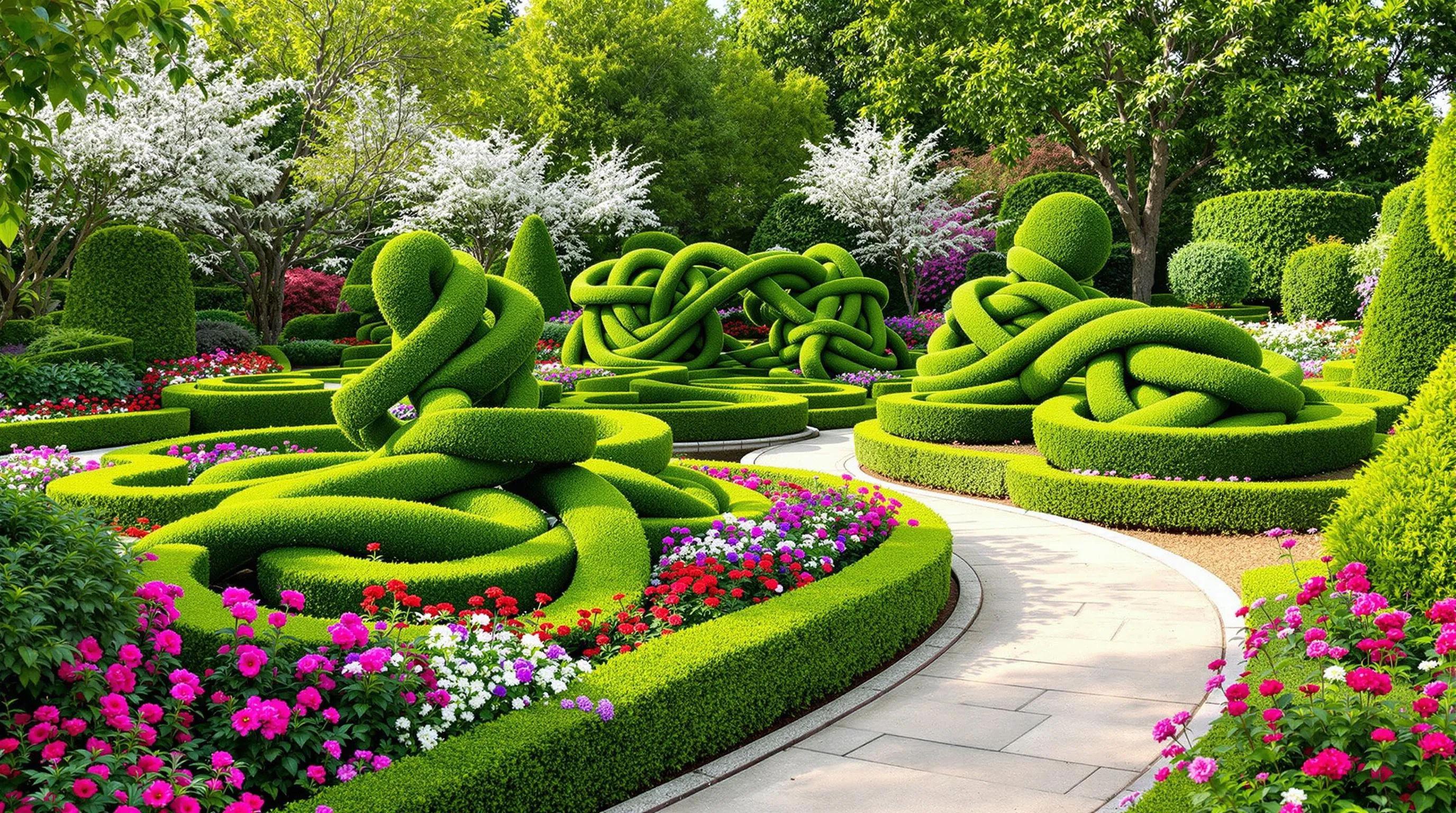
Borders and hedges define garden spaces while adding structure and elegance through the art of topiary. These living boundaries serve both practical and aesthetic purposes, guiding the eye and creating distinct garden rooms.
Formal Knot Garden Designs
Formal knot gardens offer sophisticated topiary borders that captivate with their intricate interweaving patterns. These designs draw inspiration from 16th-century European gardens where herb-filled compartments created elaborate geometric patterns. Create your own knot garden using low-growing boxwood (Buxus sempervirens) or germander (Teucrium chamaedrys) to form the “threads” of your design. Keep the patterns symmetrical for traditional appeal, and fill the spaces between with colorful flowers, herbs, or decorative gravel for contrast. For maintenance, trim your knot garden borders 2-3 times annually to maintain their crisp definition and intricate patterns. Modern adaptations can incorporate simpler patterns that still deliver visual impact without requiring extensive pruning expertise.
Living Fence Alternatives
Topiary hedges provide elegant living fence alternatives that offer privacy while improving your garden’s aesthetic appeal. Choose fast-growing varieties like privet (Ligustrum) or yew (Taxus) for establishing boundaries quickly, then shape them into undulating waves, stepped designs, or even castellated patterns resembling castle battlements. For added interest, incorporate archways or windows within your hedge line to frame garden views or create mysterious glimpses into adjacent spaces. Mix different hedge heights to create rhythm along property lines, transitioning from taller sections for privacy to lower portions that showcase featured plantings. Add lighting to cast dramatic shadows from your sculpted hedges after dark, highlighting their artistic forms and extending your garden’s enjoyment into evening hours.
Lighting Your Topiary Garden: Showcasing Shapes After Dark
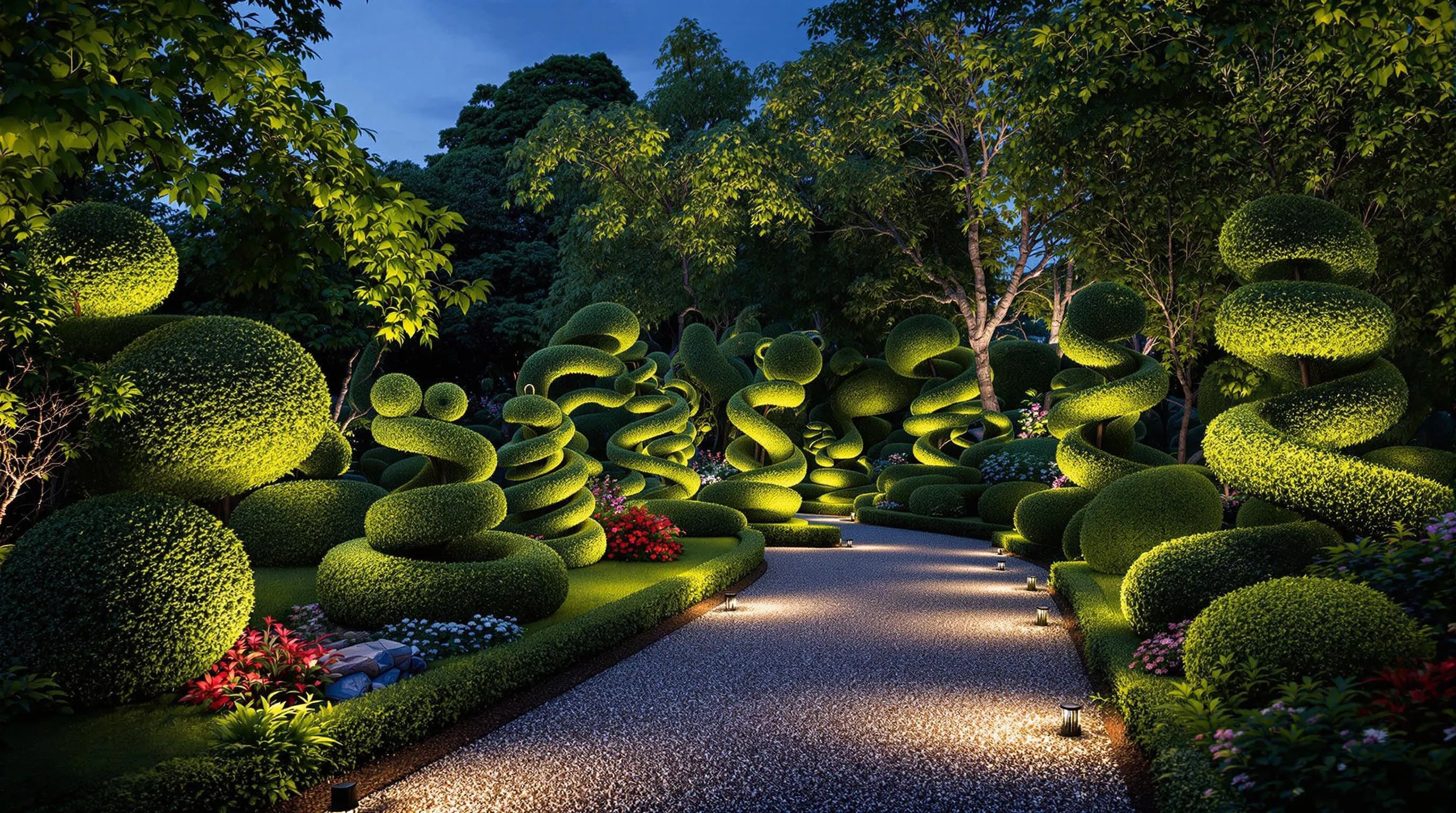
Properly illuminating your topiary garden extends its beauty into the evening hours, transforming your carefully crafted shapes into dramatic nighttime features. Strategic lighting not only enhances security but also creates an entirely new garden experience after sunset.
Solar Lighting Answers
Solar lighting offers an eco-friendly, cost-effective way to illuminate your topiary garden without complex wiring. These self-sufficient fixtures absorb sunlight during the day and automatically activate at dusk, highlighting your living sculptures throughout the evening. Position solar path lights around the base of larger topiaries to create an upward glow that accentuates their silhouettes. For more versatility, try solar string lights draped through or around medium-sized topiaries, creating a magical, starry effect. Stake-mounted solar spotlights work particularly well when angled toward statement pieces like spiral or animal topiaries, casting interesting shadows that add depth to your nighttime garden. Choose solar fixtures with warm white LEDs rather than harsh blue-toned lights to preserve the natural beauty of your plants while extending viewing hours well into the evening.
Dramatic Spotlight Techniques
Spotlighting creates theatrical effects that transform your topiaries into nighttime focal points through strategic illumination. Position low-voltage LED spotlights at the base of your topiary sculptures, angling them upward to cast dramatic shadows that emphasize the three-dimensional quality of your living art. For larger specimens, use cross-lighting with fixtures placed at different angles to eliminate harsh shadows and reveal the full complexity of the shapes. Experiment with colored filters for special occasions—amber tones create a warm, inviting atmosphere while blue can evoke a moonlit effect on formal geometric topiaries. Install dimmable systems that allow you to adjust brightness levels according to the season or event, providing flexibility for year-round enjoyment. Remember to direct lights away from windows and neighboring properties to prevent light pollution while still showcasing your topiary masterpieces in their best nocturnal light.
DIY Topiary Frame Projects for Home Gardeners

Creating your own topiary frames allows you to design custom living sculptures while saving money. These DIY projects combine craftsmanship with gardening for truly personalized garden art.
Wire Frame Construction Tips
Start your DIY topiary journey with proper wire frame construction. Choose 14-gauge galvanized wire for outdoor durability and 16-gauge for smaller, indoor projects. Sketch your design before bending, using needle-nose pliers to create precise curves and corners. Connect sections with wire wrapping or twist ties for stability. Create internal supports by adding cross-braces to prevent your frame from collapsing under plant weight. Spray paint your completed frame with rust-resistant coating in green or brown to blend with foliage. For beginners, try simple geometric shapes like spheres or cones before attempting complex animal forms. Secure your frame firmly in soil or containers using extended wire “legs” that anchor several inches deep for wind resistance.
Moss-Filled Topiary Forms
Moss-filled topiary forms offer instant gratification while plants establish themselves. Start with a pre-made wire frame or your custom creation, then line it completely with sheet moss, securing with fishing line or thin wire. Create a moistened mixture of potting soil, peat moss, and water-retaining polymer crystals to fill your form. Plant small-leafed ivy, creeping fig, or wire vine cuttings through the moss at 2-inch intervals, inserting stem ends into the soil mixture. Mist your creation daily and rotate weekly for even growth. These living sculptures work exceptionally well for indoor displays or shaded patios where traditional topiary plants might struggle. For seasonal interest, incorporate flowering plants like million bells or lobelia among the greenery. Your moss topiary requires consistent moisture but offers the advantage of a fully-formed appearance from day one.
Maintaining Your Topiary Garden Through the Seasons
Your topiary garden is more than just a collection of sculpted plants—it’s a living art form that transforms your outdoor space into something truly extraordinary. Whether you’ve opted for classic European designs geometric shapes animal sculptures or space-saving container displays the beauty of topiary lies in its versatility and timeless appeal.
With the right plants proper lighting and seasonal adaptations your living sculptures will continue to evolve and enchant for years to come. From DIY frames to dramatic spotlighting the possibilities are endless for creating a personalized topiary garden that reflects your unique style and vision.
Now it’s time to grab your shears let your creativity flourish and watch as your garden becomes a stunning showcase of horticultural artistry that delights in every season.







